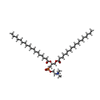+Search query
-Structure paper
| Title | Familial Alzheimer mutations stabilize synaptotoxic γ-secretase-substrate complexes. |
|---|---|
| Journal, issue, pages | Cell Rep, Vol. 43, Issue 2, Page 113761, Year 2024 |
| Publish date | Feb 12, 2024 |
 Authors Authors | Sujan Devkota / Rui Zhou / Vaishnavi Nagarajan / Masato Maesako / Hung Do / Arshad Noorani / Caitlin Overmeyer / Sanjay Bhattarai / Justin T Douglas / Anita Saraf / Yinglong Miao / Brian D Ackley / Yigong Shi / Michael S Wolfe /   |
| PubMed Abstract | Mutations that cause familial Alzheimer's disease (FAD) are found in amyloid precursor protein (APP) and presenilin, the catalytic component of γ-secretase, that together produce amyloid β-peptide ...Mutations that cause familial Alzheimer's disease (FAD) are found in amyloid precursor protein (APP) and presenilin, the catalytic component of γ-secretase, that together produce amyloid β-peptide (Aβ). Nevertheless, whether Aβ is the primary disease driver remains controversial. We report here that FAD mutations disrupt initial proteolytic events in the multistep processing of APP substrate C99 by γ-secretase. Cryoelectron microscopy reveals that a substrate mimetic traps γ-secretase during the transition state, and this structure aligns with activated enzyme-substrate complex captured by molecular dynamics simulations. In silico simulations and in cellulo fluorescence microscopy support stabilization of enzyme-substrate complexes by FAD mutations. Neuronal expression of C99 and/or presenilin-1 in Caenorhabditis elegans leads to synaptic loss only with FAD-mutant transgenes. Designed mutations that stabilize the enzyme-substrate complex and block Aβ production likewise led to synaptic loss. Collectively, these findings implicate the stalled process-not the products-of γ-secretase cleavage of substrates in FAD pathogenesis. |
 External links External links |  Cell Rep / Cell Rep /  PubMed:38349793 / PubMed:38349793 /  PubMed Central PubMed Central |
| Methods | EM (single particle) |
| Resolution | 2.6 Å |
| Structure data | EMDB-36948, PDB-8k8e: |
| Chemicals |  ChemComp-NAG:  ChemComp-PC1:  ChemComp-CLR: |
| Source |
|
 Keywords Keywords |  MEMBRANE PROTEIN / MEMBRANE PROTEIN /  Complex / Complex /  protease / substrate mimetic protease / substrate mimetic |
 Movie
Movie Controller
Controller Structure viewers
Structure viewers About Yorodumi Papers
About Yorodumi Papers






